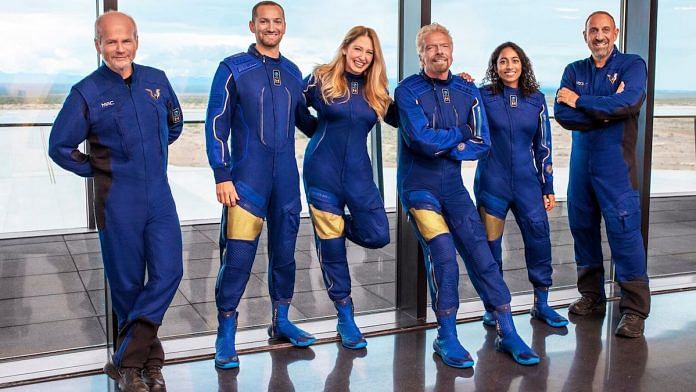The first space tourist was US millionaire Dennis Tito who hitched a ride to the International Space Station with the Soviet Soyuz in 2001 and stayed as a crew member on board the space station for eight days. Since then, there have been 12 space tourists who visited the ISS, all launched on the Russian Soyuz rocket.
There has been a lull in such private trips to space the last decade until Virgin Galactic’s big event on 11 July. Richard Branson along with three of Virgin’s employees experienced several minutes of weightlessness as they rode on a winged plane — SpaceShipTwo — that was in turn air-launched by a supersonic plane, both of them developed by Virgin Galactic.
This flight has sparked an interesting debate in the space community on whether these four space tourists can be considered astronauts. One argument is that since they have received astronaut wings and have undergone some sort of training, they are definitely astronauts. The counterargument is a thought-provoking analogy on comparing these four space tourists to commercial airline passengers.
The Virgin Galactic team reached an altitude of around 90 km and since the US awards astronaut wings to anyone who crosses the 80 km altitude, they can definitely be considered as space tourists.
Also read: Branson made it to space, and Bezos will follow suit. But honestly, no one really cares
Who are astronauts
The very term ‘astronaut’ is actually a job designation at National Aeronautics and Space Administration (NASA). And digging into the origins of this word, it was introduced by NASA at the beginning of the space race to differentiate their astronauts from the Soviet cosmonauts and perhaps to claim supremacy over the Soviets who beat the Americans to space with both Sputnik and Yuri Gagarin. Whatever be the origins, the term astronaut has evolved to be an aspirational beacon for starry eyed kids and teens across the world, and has been one of the largest inspirations for generations of space engineers and scientists to pursue a career in space. By this logic, one could also want to preserve its sanctity and refuse to confer astronaut status on space tourists. Being an astronaut would lose its charm if anyone can simply buy their way into being one.
I would personally be happy to refer to the two pilots who manoeuvred the spaceplane with incredible acumen towards a perfect landing as astronauts. This is because, while the spaceplane fired its rocket motor during the ascent after air launch, the reentry was a fully manual and unpowered glide at Mach 3 speed, relying completely on the skill of the pilots for a safe landing.
This question would also be interesting from a legal standpoint, given the Rescue Agreement (an international agreement on the rights and obligations of states towards persons and objects in space) ratified by most space-faring countries does not talk about providing any special diplomatic status to space tourists.
Another interesting narrative is around the immediate future of suborbital tourism. Compared to the $10 million price tag on a trip to the ISS, Virgin’s offering of $250,000 per seat already has 600 reservations and a much longer waiting list. The immediate business potential for suborbital tourism would be similar to that of an elite theme park or a sky-diving experience for a small niche of population who can afford it.
Also read: Richard Branson completes flight to edge of space & Jeff Bezos ‘can’t wait to join the club’
Will suborbital space flights help
In a longer time frame, these sub-orbital flights can be stepping stones to point-to-point transportation on earth, similar to the current commercial airline industry. This could reduce the current flight durations of 12 hours to less than an hour. But Elon Musk-led SpaceX’s Starship might make more financial sense for this use case, given its higher payload capacity compared to Virgin Galactic’s SpaceShipTwo. Moreover, a glider like Virgin’s would require a much longer runway than current commercial flights do and is riskier given its no go-around capability while landing. Using Blue Origin’s New Shepard or SpaceX’s Starship would solve the long runway problem with their vertical take-off and landing (VTOL) but would again be risky for the spaceports closer to dense cities. Additionally, the regulatory aspects will have to be figured out, not to mention the large investments into the construction and maintenance of the space ports.
Military cargo transport could be another use case, but this would mostly be limited to a handful of wealthy countries who not only require it, but also can afford it.
While one can consider space tourism to contribute towards human presence on the Moon or Mars in future, suborbital space tourism has very little to offer here. The real stepping stone to long-duration human space flight would be the tourist missions to orbital space stations accompanied by long stays on-board. This would not only provide the much-needed data points for long-term effects of space on physiology and psychology, but also advance the development of life support systems and contribute towards self-sufficiency in space.
Watching the live stream of Virgin’s first commercial flight was quite fun but it was not as inspiring as SpaceX’s Starman, a mannequin on a Tesla (also founded by Elon Musk) roadster, launched into space. Could be the popularity of SpaceX and Elon Musk. It would be interesting to see how Blue Origin would mould the narrative during the live stream of their upcoming commercial sub-orbital flight on 20 July, which also happens to be unpiloted, and the first one at that.
Rachana Reddy is a satellite development engineer with Berlin Space Technologies in Germany. She has previously worked with the space agencies of India (ISRO) and Germany (DLR). She also hosts a podcast series Those Space People featuring casual cosmic conversations with people working on all things space. Views are personal.
(Edited by Neera Majumdar)



